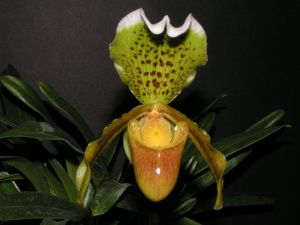No edit summary |
No edit summary |
||
| Line 10: | Line 10: | ||
This is a small to medium sized, humus epiphytic species with 5 to 6 strap-shaped, clear green leaves that are minutely bilobed apically growing on limestone outcroppings at an elevation of 1000m to 2000m in India, Bangladesh and Nepal and is a cool growing plant that flowers in late autumn and winter on a terminal, erect, to 30cm long, one and occasionally 2 flowered, dark green brown, purple-pubescent inflorescence that has an ovate, pubescent, glabrous floral bract and does not need a winter rest. This species has been used extensively in hybridizing. | This is a small to medium sized, humus epiphytic species with 5 to 6 strap-shaped, clear green leaves that are minutely bilobed apically growing on limestone outcroppings at an elevation of 1000m to 2000m in India, Bangladesh and Nepal and is a cool growing plant that flowers in late autumn and winter on a terminal, erect, to 30cm long, one and occasionally 2 flowered, dark green brown, purple-pubescent inflorescence that has an ovate, pubescent, glabrous floral bract and does not need a winter rest. This species has been used extensively in hybridizing. | ||
Latest revision as of 20:47, 11 June 2024

Common Name: The Splendid Paphiopedilum
Scented: no
Light Requirements: deep shade
Temperature Requirements: cool
Blooms: late autumn and winter
Flower Size: 10cm to 12.5cm
Synonyms: Cordula insignis Raf. 1838; Cypripedium chantini hort.; *Cypripedium insigne Wall ex Lindley 1822; Cypripedium maulei hort.; Paphiopedilum macfarlanei F.G.Mey. 1934
This is a small to medium sized, humus epiphytic species with 5 to 6 strap-shaped, clear green leaves that are minutely bilobed apically growing on limestone outcroppings at an elevation of 1000m to 2000m in India, Bangladesh and Nepal and is a cool growing plant that flowers in late autumn and winter on a terminal, erect, to 30cm long, one and occasionally 2 flowered, dark green brown, purple-pubescent inflorescence that has an ovate, pubescent, glabrous floral bract and does not need a winter rest. This species has been used extensively in hybridizing.